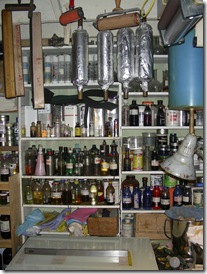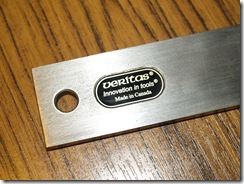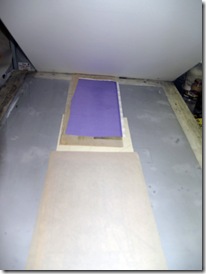Ink Slabs
 Last week I broke the glass on my ink slab for the second time in 20 years. I have leather rollers for printing colors hanging from the floor joists just above the ink slab - somehow I managed to disturb one as I was reaching for something on the shelf. As I was replacing the broken glass, I remembered the number of ink slabs and subplates that I have run into at the various workshops over the years. Many of these were either hollow or raised in the middle just enough to not produce an even layer of ink when used with a harder durometer roller.
Last week I broke the glass on my ink slab for the second time in 20 years. I have leather rollers for printing colors hanging from the floor joists just above the ink slab - somehow I managed to disturb one as I was reaching for something on the shelf. As I was replacing the broken glass, I remembered the number of ink slabs and subplates that I have run into at the various workshops over the years. Many of these were either hollow or raised in the middle just enough to not produce an even layer of ink when used with a harder durometer roller.
Leather rollers have enough give to take uneven surfaces into account if not too severe, but good rubber rollers will not lay down a level film of ink on the plate in most cases. This becomes apparent when printing large areas of delicate smooth tints using any structure of dot patterns - like toner washes or laser halftone and inkjet photoplates.
My 45 durometer 3-part roller system will show up this snag when using a very thin film of ink required when printing with linear offset. Unlike traditional litho, using leather rollers with heavier inking, offset requires a thinner ink film to prevent dot gain due to squeeze from the rubber blanket, which produces darkening of the image. Flatness of the ink slab and subplate are therefore more important when using offset - especially with transparent ink.
I believe that most printers do not realize that even a 1/4 inch sheet of glass is flexible enough to show up any unevenness of the surface it is laying on. Today’s fiber optics proves this point as thin can be bent into considerable tight curves without damage. Getting your table completely flat under the glass slab is the first step of making a good ink up slab.
 What level of tolerance is necessary for good printing? The first problem is finding a long enough straight edge to be totally effective. If possible, go for the best, which would be the same as grinding the surface of a large litho stone - less than the thickness of a piece of writing paper - about .003 of an inch. The straight edge to meet this standard and could be expensive for one around 24 inches long. Those on the market will have accuracy of .001 over the entire 24" length for steel ones and .003 for aluminium. You have a choice on how much this is worth to you as steel is roughly twice as expensive. Nothing over 24" would be needed as most rollers are under 18" wide.
What level of tolerance is necessary for good printing? The first problem is finding a long enough straight edge to be totally effective. If possible, go for the best, which would be the same as grinding the surface of a large litho stone - less than the thickness of a piece of writing paper - about .003 of an inch. The straight edge to meet this standard and could be expensive for one around 24 inches long. Those on the market will have accuracy of .001 over the entire 24" length for steel ones and .003 for aluminium. You have a choice on how much this is worth to you as steel is roughly twice as expensive. Nothing over 24" would be needed as most rollers are under 18" wide.
 The usual method to check flatness is to use three strips of paper cut from the same sheet. These are place at the ends and middle of the straight edge; then if you can pull out any of the pieces, that area is lower by at least the thickness of the paper - but it could be much more. Stack small pieces of paper to estimate the discrepancy.
The usual method to check flatness is to use three strips of paper cut from the same sheet. These are place at the ends and middle of the straight edge; then if you can pull out any of the pieces, that area is lower by at least the thickness of the paper - but it could be much more. Stack small pieces of paper to estimate the discrepancy.
I chose an acrylic adhesive I had that was meant for tile, which I spread with a notched piece of aluminium. This would allow me to put pressure unto those areas that were high when tested with the straight edge. A solid layer of adhesive would be harder to depress and would influence the areas next to it. The slab was left to cure in the hope that evaporation of water did not change the flatness of the surface.
Subplates
The same problem is encountered in subplates used for waterless lithography. While these can be made from old plates, hardboard and glass, I believe 1/4 " plate glass is the best in the long run for a serious waterless printer. Used plate glass can be purchased at places that sell materials donated by construction firms for sale to people on a tight budget. The surface is ground to hold silicone better by using a piece of marble with 220 grit silicon carbide; much the same as resurfacing litho limestones.
 With the larger surface needed to roll up a plate, getting it flat may be more difficult. I had originally used a large litho plate that I had glued to a sheet of 3/4 in plywood, to find there was a serious hollow in the subplate that could only be improved by using plate glass. You can see in the picture that quite a bit of paper has been added under the glass to produce a good flat surface. I have found that this might change with the difference of humidity after a rain - or the drier studio during winter time.
With the larger surface needed to roll up a plate, getting it flat may be more difficult. I had originally used a large litho plate that I had glued to a sheet of 3/4 in plywood, to find there was a serious hollow in the subplate that could only be improved by using plate glass. You can see in the picture that quite a bit of paper has been added under the glass to produce a good flat surface. I have found that this might change with the difference of humidity after a rain - or the drier studio during winter time.
So how important is this to you? It depends on the images you print with the type of press and paper you use. How professional are you in the approach to printing editions? The goal of good printers is to have very little if any variation in the printed edition. On flats and the higher pressure used on direct transfer presses, it will likely be less of a problem. For those using offset proofing presses, this might be of greater concern. As I have noticed while doing workshop in other studios, I have had to improve those ink slabs were the glass could be lifted and packed in the low areas. This can be the printing problem some may not look at to get better editions.
